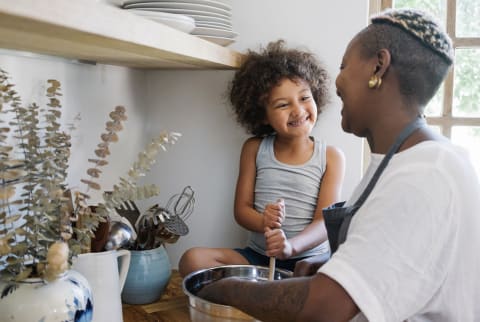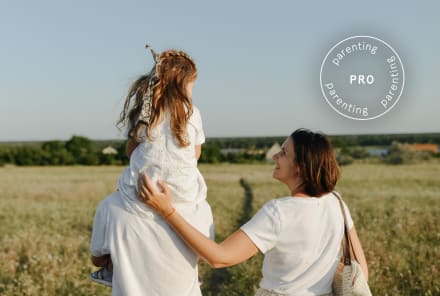Advertisement

As a lifelong yogi and new mother, I'm continuously inspired to bring the mindfulness I've been practicing for the past decade into our home and child's upbringing. Yoga and meditation have been steadfast through my pregnancy and since our daughter's birth, and we're now working on instilling the same mindful principles in her. The consistency of a mindful morning routine can positively influence your energy levels, attitude, and performance throughout your day, so why not include your children in this? Just as quick as her sleep patterns can go awry, she can also wake up by offering a kiss and start reaching to the sky with deep breaths.
Encouraging mindfulness and thoughtful rituals in kids may sound like a tall order, but I've found it becomes a lot easier when you keep it simple and layer some practices into what you already have going on. Although it's taken different shapes and I may not get my solid 20 minutes of quiet meditation or uninterrupted yoga time like I used to, making adjustments so mindfulness works for us all and including my daughter in simple practices is completely worth it.
How kids benefit from routines.
Just as we parents crave routines for ourselves, we should likewise strive to create structure and ease that's healthy for our children to start their day as well. Science has shown time and time again that routinized schedules help with early development1, with such kids growing up with fewer attention problems, better time management skills, better emotional control, and even less risk of obesity2. According to one analysis in the Infants & Young Children journal, young children are keenly aware of the daily, weekly, and annual rhythms of family life and eager to be involved as central players.
"Naturally occurring family routines and meaningful rituals provide both a predictable structure that guides behavior and an emotional climate that supports early development," the researchers explain. "In previous studies, this emotional commitment to rituals has been found to be associated with adolescent sense of identity and lower rates of anxiety symptoms under high-risk conditions."
That report cites another study that tracked young children for five years beginning at age 4 and found "families who showed a stable, high level of commitment in their rituals" over that five-year period had kids who did better in school than kids who had less routine at home.
Why morning routines are perfect for teaching mindfulness to kids.
While making sure our kids get enough sleep, brush their teeth, and eat breakfast is vitally important, adding in mindful practices that are grounding, calming, and purposeful can help provide long-lasting self-regulation skills (for everyone).
There is plenty of research out there confirming mindfulness has loads of benefits, and these days, the data has also begun expanding beyond adults and deeper into adolescent psychology. Mindfulness can boost kids' mental health3, attention, and social competency, to name just a few.
With the doors on mindfulness research swung wide open now, mindfulness in our education systems curricula has begun to grow rapidly. Many schools4 are shifting detention rooms focusing on punishment into teaching kids how to meditate5 with a focus on quieting the mind, and they're showing progressive results with a need for continued research. Programs like the Goldie Hawn Foundation's MindUp and Mindfulness in Schools Project are just two examples of the plethora of offerings out there, all trying to help young people access these far-reaching benefits of mindfulness.
All the more reason we parents should follow suit and start those lessons in the home.
Three mindful morning routines for kids.
Understanding what mindfulness means yourself will be key if you plan on teaching this to your youngsters in an age-appropriate way. Jon Kabat-Zinn, a mindfulness researcher and creator of the Mindfulness-Based Stress Reduction program, describes mindfulness as "awareness that arises through paying attention, on purpose, in the present moment, nonjudgmentally." I love the simplicity of this conscious notion as we find a place to begin.
With that, here are three mindful practices to infuse into your existing morning routine with your kids. Laying a foundation for kids to feel safe and comfortable can be achieved when things are well-planned, predictable, and consistent—yet flexible.
1. Waking up with mindful breathing.
What does this look like for your family? Are your kids usually in bed with you or tucked into their own beds in their own rooms? Either way is absolutely wonderful, and you can create a mindful breathing practice in any bedroom you're waking up in. Mindful awareness of breath is a great building block for other healthy mindful practices and can help regulate emotions at any given point throughout our days.
Sit at the edge of the bed together and place one hand on your heart and one on your belly to start your day with six deep breaths. Notice how the belly and heart rise and fall as you inhale through the nose and exhale out through the mouth for the first three. For the next three, add the arms. As you inhale, sweep the arms up to the sky. As you exhale, bring the hands to heart center. This makes for a good morning stretch and mindful movement linked to your breath.
2. Gratitude at breakfast time.
Breakfast can be a wonderful family bonding time if you create it intentionally. Today, it's easy to allow devices to take the place of interaction with each other. Kids watching an overstimulating program or playing a mindless game on an app is an effortless way for them to tune out of engaging face-to-face and be consumed by a screen. Technology has tremendous capabilities and many benefits, but that presents new challenges we have to be mindful about and lead by example. Try no devices or TV during the morning routine and take note of any positive changes.
At breakfast time, hold your hands over your heart and each take a turn saying something you're grateful for. Having gratitude is one of the best ways to create joy, shift from negative energy, and cultivate more happiness. If your child isn't quite speaking yet (ours is 20 months old), teach them the word gratitude and what it means. In a matter of a few days, our toddler began putting her hands on her heart as we sat to eat, often reminding us to say our grateful thought. They pick up routines quickly.
3. Observation window fun.
This next one can be done anytime in your morning routine, but try to choose a moment to stack it with something everyone does, and keep it consistent. It could be once everybody is dressed, right after breakfast, maybe as the teeth are getting brushed, or on the way out the door. There are plenty of moments to choose from.
Find a window or head outside to find something to observe. Look for something that you can focus on for at least one minute, and describe it as vividly as possible. Encourage your kids to turn on their senses. Again, if your little one is not quite talking, you can prompt descriptive words and see how they engage. Clouds, trees, animals, the sky, the weather…nature is a great place to find things to look at. Stimulating their imagination, creativity, and ability to watch something closely brings them right into the present moment.
Get creative.
These are some simple ways to get mindfulness flowing in your home as you start your day. Building on these practices and adding more layers can be fun too: journaling, creating a gratitude jar, finding a quiet place to sit and meditate together, practicing yoga side by side, just to name a few. Exploring mindfulness is creative and enjoyable. Just remember to focus on the essence of being aware in the present moment.
And don't forget to model mindfulness yourself too.
I firmly believe children learn by example, so having your own practice that they can witness or be aware of is also essential. As we demonstrate our model of mindfulness through being able to self-regulate our emotions and responsive minds, we deepen our children's ability to do the same. Roll out a mat for them to practice yoga next you or invite them to sit quietly with you as you meditate. They will bear witness to our ability to shift into awareness of the present moment, and we connect deeper to our own parenting experience. That is a win-win for everyone. Imagine the benefits that they could carry with them throughout their lives when we start early.
Raising our children can be the ultimate mindful practice if we choose it to be. When we look at it as a fundamental parenting skill that takes a conscious effort consistently, we can really start to make a difference.
Watch Next
Enjoy some of our favorite clips from classes
Enjoy some of our favorite clips from classes
What Is Meditation?
Mindfulness/Spirituality | Light Watkins
Box Breathing
Mindfulness/Spirituality | Gwen Dittmar
What Breathwork Can Address
Mindfulness/Spirituality | Gwen Dittmar
The 8 Limbs of Yoga - What is Asana?
Yoga | Caley Alyssa
Two Standing Postures to Open Up Tight Hips
Yoga | Caley Alyssa
How Plants Can Optimize Athletic Performance
Nutrition | Rich Roll
What to Eat Before a Workout
Nutrition | Rich Roll
How Ayurveda Helps Us Navigate Modern Life
Nutrition | Sahara Rose
Messages About Love & Relationships
Love & Relationships | Esther Perel
Love Languages
Love & Relationships | Esther Perel












